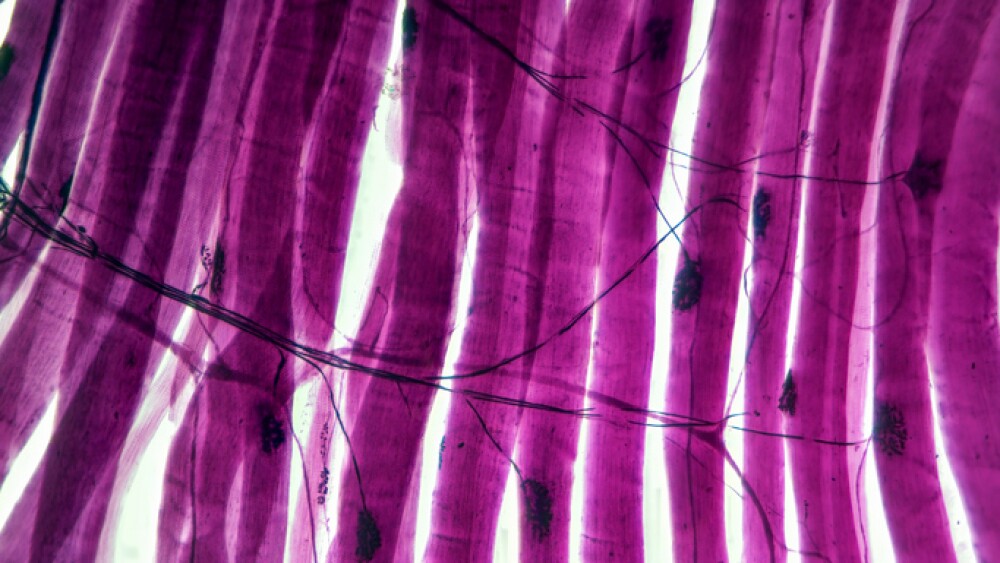Alterity Therapeutics (ASX: ATH, NASDAQ: ATHE) (“Alterity” or “the Company”), a biotechnology company dedicated to developing disease modifying treatments for neurodegenerative diseases, today announced that new data are being presented in a poster session today from the Company’s ongoing Biomarkers of progression in Multiple System Atrophy (bioMUSE) study today at the American Academy of Neurology (AAN) Annual Meeting.
MELBOURNE, Australia and SAN FRANCISCO, April 6, 2022 /PRNewswire/ -- Alterity Therapeutics (ASX: ATH, NASDAQ: ATHE) ("Alterity" or "the Company"), a biotechnology company dedicated to developing disease modifying treatments for neurodegenerative diseases, today announced that new data are being presented in a poster session today from the Company's ongoing Biomarkers of progression in Multiple System Atrophy (bioMUSE) study today at the American Academy of Neurology (AAN) Annual Meeting taking place in Seattle, Washington, USA. BioMUSE is a natural history study that is tracking disease progression in individuals with early Multiple System Atrophy (MSA), a Parkinsonian disorder without approved therapy. The study is being conducted in collaboration with Vanderbilt University Medical Center in the U.S. under the direction of Daniel Claassen, MD, Associate Professor of Neurology and Principal Investigator. The poster presented by Dr. Claassen, entitled, "Iron Accumulation Correlates with Disease Severity in Patients with Multiple System Atrophy" assesses the relationship between iron accumulation and symptom severity in patients with MSA. The study showed that advanced quantitative MRI methods demonstrated pathological iron accumulation in MSA patients that relate to clinical severity. The data also support the use of quantitative susceptibility mapping (QSM) as a biomarker of disease severity in MSA. "BioMUSE is a groundbreaking study in the evaluation of early stage MSA patients to track disease progression and select biomarkers for evaluating target engagement and preliminary efficacy of clinical development compounds," said Dr. Claassen. "Through brain imaging, we have been able to measure and track iron accumulation in various brain regions of Parkinson's disease (PD) and MSA patients that contributes to disease progression. The study reinforces our belief that early diagnosis of MSA is vital for maximizing neuronal preservation with disease modifying therapies." David Stamler, MD, Chief Executive Officer, Alterity, added, "The ongoing bioMUSE trial continues to validate our approach of reducing iron accumulation to inhibit α–synuclein aggregation, rescue neurons and improve function in MSA patients. We expect to launch our global Phase 2 clinical trial of ATH434 in early-stage MSA in the second quarter of 2022, and we are grateful to Dr. Claassen and his team for this important work to help guide our clinical development program." The presentation includes data from 52 individuals, 17 with MSA, 17 with PD, and 18 age–matched healthy controls with a mean age between 60 and 65 years of age. The MRI results show that while iron accumulates in the brains of both PD and MSA patients, there are clear distinctions. In comparison to PD, significantly increased iron concentration in MSA patients was noted in the lentiform nucleus (LFN) and dentate nucleus (DN) of the brain. These regions play a key role in muscle coordination and control of voluntary movements. Compared to healthy controls, MSA patients had greater iron concentration in the substantia nigra (SN) and DN. The substantia nigra is a critical brain region for the production of dopamine and affects many functions of the central nervous system including movement control, learning and emotion. In MSA, greater iron concentration in the SN and external globus pallidus (GPe) positively correlated with severity as measured by the Unified Multiple System Atrophy Rating Scale (UMSARS) and Natural History and Neuroprotection in Parkinson Plus Syndromes (NNIPPS) rating scales. About bioMUSE Biomarkers of progression in Multiple System Atrophy (bioMUSE) is an ongoing, natural history study that aims to track the progression of patients with MSA, a Parkinsonian disorder without approved therapy. The study is being conducted in collaboration with Vanderbilt University Medical Center in the U.S. under the direction of Daniel Claassen, MD, Associate Professor of Neurology and Principal Investigator. Natural history studies are important for characterizing disease progression in selected patient populations. The study has provided rich data for optimizing the design of Alterity's Phase 2 clinical trial and will be expanded to include a total of 20 patients with MSA. The ongoing study will continue to provide vital information on early stage MSA patients, inform the selection of biomarkers suitable to evaluate target engagement and preliminary efficacy, and deliver clinical data to characterize disease progression in a patient population that mirrors those to be enrolled in the Phase 2 clinical trial. About Multiple System Atrophy Multiple System Atrophy (MSA) is a rare, neurodegenerative disease characterized by failure of the autonomic nervous system and impaired movement. The symptoms reflect the progressive loss of function and death of different types of nerve cells in the brain and spinal cord. It is a rapidly progressive disease and causes profound disability. MSA is a Parkinsonian disorder characterized by a variable combination of slowed movement and/or rigidity, autonomic instability that affects involuntary functions such as blood pressure maintenance and bladder control, and impaired balance and/or coordination that predisposes to falls. A pathological hallmark of MSA is the accumulation of the protein α-synuclein within glia, the support cells of the central nervous system, and neuron loss in multiple brain regions. MSA affects approximately 15,000 individuals in the U.S., and while some of the symptoms of MSA can be treated with medications, currently there are no drugs that are able to slow disease progression and there is no cure.[1] [1]National Institutes of Health: Neurological Disorders and Stroke, Multiple System Atrophy Fact Sheet About ATH434 Alterity's lead candidate, ATH434, is the first of a new generation of small molecules designed to inhibit the aggregation of pathological proteins implicated in neurodegeneration. ATH434 has been shown preclinically to reduce α-synuclein pathology and preserve nerve cells by restoring normal iron balance in the brain. In this way, it has excellent potential to treat Parkinson's disease as well as various forms of atypical Parkinsonism such as Multiple System Atrophy (MSA). ATH434 has successfully completed a Phase 1 clinical trial demonstrating the agent is well tolerated, orally bioavailable, and achieved brain levels comparable to efficacious levels in animal models of MSA, with the objective of restoring function in patients with MSA and other Parkinsonian disorders. ATH434 has been granted Orphan designation for the treatment of MSA by the U.S. FDA and the European Commission. About Alterity Therapeutics Limited Alterity Therapeutics is a clinical stage biotechnology company dedicated to creating an alternate future for people living with neurodegenerative diseases. The Company's lead asset, ATH434, has the potential to treat various Parkinsonian disorders. Alterity also has a broad drug discovery platform generating patentable chemical compounds to intercede in disease processes. The Company is based in Melbourne, Australia, and San Francisco, California, USA. For further information please visit the Company's web site at www.alteritytherapeutics.com. Authorisation & Additional information This announcement was authorized by David Stamler, CEO of Alterity Therapeutics Limited. Forward Looking Statements This press release contains "forward-looking statements" within the meaning of section 27A of the Securities Act of 1933 and section 21E of the Securities Exchange Act of 1934. The Company has tried to identify such forward-looking statements by use of such words as "expects," "intends," "hopes," "anticipates," "believes," "could," "may," "evidences" and "estimates," and other similar expressions, but these words are not the exclusive means of identifying such statements. Important factors that could cause actual results to differ materially from those indicated by such forward-looking statements are described in the sections titled "Risk Factors" in the Company's filings with the SEC, including its most recent Annual Report on Form 20-F as well as reports on Form 6-K, including, but not limited to the following: statements relating to the Company's drug development program, including, but not limited to the initiation, progress and outcomes of clinical trials of the Company's drug development program, including, but not limited to, ATH434, and any other statements that are not historical facts. Such statements involve risks and uncertainties, including, but not limited to, those risks and uncertainties relating to the difficulties or delays in financing, development, testing, regulatory approval, production and marketing of the Company's drug components, including, but not limited to, ATH434, uncertainties relating to the impact of the novel coronavirus (COVID-19) pandemic on the company's business, operations and employees, the ability of the Company to procure additional future sources of financing, unexpected adverse side effects or inadequate therapeutic efficacy of the Company's drug compounds, including, but not limited to, ATH434, that could slow or prevent products coming to market, the uncertainty of obtaining patent protection for the Company's intellectual property or trade secrets, the uncertainty of successfully enforcing the Company's patent rights and the uncertainty of the Company freedom to operate. Any forward-looking statement made by us in this press release is based only on information currently available to us and speaks only as of the date on which it is made. We undertake no obligation to publicly update any forward-looking statement, whether written or oral, that may be made from time to time, whether as a result of new information, future developments or otherwise.
SOURCE Alterity Therapeutics Limited |
||
Company Codes: Australia:ATH, NASDAQ-NMS:ATHE |





